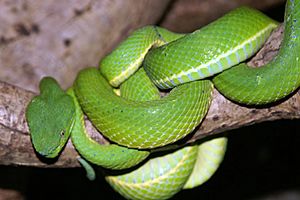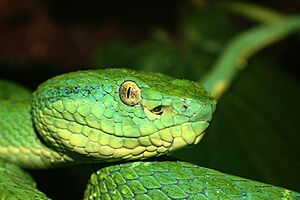Bothriechis lateralis facts for kids
Quick facts for kids Bothriechis lateralis |
|
|---|---|
 |
|
| Conservation status | |
| Scientific classification | |
| Genus: |
Bothriechis
|
| Species: |
lateralis
|
Bothriechis lateralis is a type of venomous snake known as a pit viper. It is found in the mountains of Costa Rica and western Panama. People also call it the side-striped palm-pitviper, green palm viper, or parrot viper.
Contents
How Does the Side-Striped Palm Pitviper Look?
These snakes are usually quite slender. Adults can grow over 80 cm (about 2.5 feet) long, but some can reach more than 100 cm (over 3 feet). They have a special tail that can grip branches, helping them move through trees.
The snake's body is usually a bright emerald green or bluish-green. It has yellow stripes that run vertically (up and down) along its back. Sometimes, you might see blue or black tips on the scales next to these yellow stripes. Its belly is a yellowish-green, with a pale yellow stripe along its sides. The top of its head is green, and some snakes might have a faint blue or blue-gray stripe behind their eyes. Their eyes are yellow.
Young snakes look a bit different. They are usually brown with dark brown marks on their heads. Their eyes are bronze, and their tail tip is yellow or a bright greenish-yellow. After about six months, their color starts to change to a dull lime green. It takes about 18 to 24 months for them to get their full adult colors.
Sometimes, these green snakes can turn blue over time, especially when they are kept in zoos. Blue ones are also sometimes found in the wild.
Where Does the Side-Striped Palm Pitviper Live?
This snake lives in the mountains of Costa Rica and western Panama. You can find it in mountain ranges like the Cordillera de Tilarán and the Cordillera de Talamanca. It lives at altitudes between 850 and 980 meters (about 2,800 to 3,200 feet) above sea level.
What Kind of Home Does It Like?
The side-striped palm pitviper prefers to live in wet mountain forests, including lower montane forest and rainforest. While it can sometimes survive in areas changed by farming, like coffee farms, it seems to be disappearing from these places. However, it is quite common in protected areas, where its populations are doing well.
How Does It Behave?
This snake spends most of its time in trees and bushes. It is an arboreal species, meaning it lives in trees. You can often find it coiled up at the bottom of palm leaves. These snakes like to stay still and use their amazing camouflage to hide from predators. They usually won't attack unless they are touched. But if they feel threatened, they can strike very quickly!
What Does It Eat?
The side-striped palm pitviper uses its gripping tail not just to rest, but also to hold on when it strikes at its prey. It eats small birds, rodents, lizards, and frogs.
About Its Venom
A bite from this snake can be serious, but it is very rare for someone to die from it. There is a special medicine called an antivenin that can treat bites from this species. It is made in Costa Rica.



